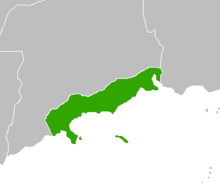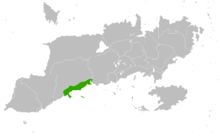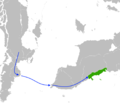Uspria
| The Imperial Dominion of Uspria | ||||
|---|---|---|---|---|
|
||||
| Motto: Progress Through Unity | ||||
| Anthem: Our Empress Ascendant | ||||
Location of Uspria
|
||||
Location of Uspria on Aurora
|
||||
| Capital and largest city | Shesa | |||
| Official Languages | Liuri Staynish |
|||
| Ethnic groups (2019) | 100% Human | |||
| Demonym | Usprian | |||
| Government | Divine Absolute Monarchy | |||
| - | Emperess | Ayrinn Taube | ||
| - | Prime minister | Ronya Etusi | ||
| Legislature | Parliament | |||
| - | Upper house | Senate | ||
| - | Lower house | Chamber of Representatives | ||
| Area | ||||
| - | Total | 298,200 km2 115,135 sq mi |
||
| Population | ||||
| - | 2019 census | |||
| - | Density | 228.81/km2 592.63/sq mi |
||
| GDP (nominal) | 2019 estimate | |||
| - | Total | $1.808 Trillion ☥1.175 Trillion |
||
| - | Per capita | $26,500 ☥17,225 |
||
| Gini (2019) | 29.3 low |
|||
| HDI (2019) | 0.933 very high |
|||
| Currency | Marks (☥/UM) |
|||
| Time zone | Tellith Mean Time (UTC+6) | |||
| Date format | DD/MM/YYYY | |||
| Drives on the | left Side | |||
| Calling code | +80 | |||
| ISO 3166 code | .IUI | |||
| Internet TLD | .IUI | |||
Contents
Etymology
History
Mesolithic Uspria (8800-5800 BC)
Although the exact date is still hotly debated amongst historians and scholars it is within the Mesolithic Era that elves from what would become modern day Arcturiasaid eastward towards the continent of Aurora. Utilizing ancient voyager ships the elves bridged the gap between the two landmasses. The elves proceeded across the southern coast of Aurora following native populations of Aurochs along the southern coast of Aurora and into what would become modern Uspria. While archaeological records are scarce archaeologists have found remains of old stone tools and decorative art that described the nomadic proto Usprian people. Within the caves remains of shattered pottery were found along with trace residue of foodstuffs as well as salt withing the shards, suggesting that ancient Usprians utilized a method of desalinating water to utilize the salt for enhancing or preserving food.
Close to the late Mesolithic Usprians settled into into what would become modern day Uspria. Settlers built tightly packed mudbrick settlements along the cliffside. based upon historical artifacts recovered this was the same time in which early Usprians began the domestication of a Hapsi, a medium-grained rice. It is theorized early Usprians utilized hapsi as well as hunting game and fish to consume. Wild mango, nuts, berries, and seeds were also used to supplement dietary needs deeper inland. Those who settled upon the rocky shores of Uspria ate much higher proportions of fish, mollusk, and berries that grew within the rocky crags of the mountainous coastline. Early Usprians also used a variety of domesticated animals for travel, food, labor, and clothing. Some of the earliest examples are the early domestication of goats, auroran pheasants, and Hummarian Aurochs.
Early Usprian society was still highly tribal during this period however limited instances of bartering and cultural exchange did occur between the different settled tribes as well as native human populations. It is theorized the Usprian people traded foodstuff, seeds, livestock, and handicrafts. During the late Mesolithic period early Usprians developed the groundwork for the Aocini faith as evidenced by exhumed remains featuring jewelry and talismans reminiscent of the symbolism used in modern Aocini.
Neolithic Uspria (5800-4500 BC)
Chalcolithic Uspria (4500-3500 BC)
Politics
Uspria is defined as an absolute monarchy headed by the Taube Dynasty. The leading member of the dynasty holds the title of empress and serves for life, although abdication to another member of the dynasty is allowed and within the rights of the empress. The empress is supported by a hand picked cabinet of leaders and representatives from the Parliament as well as a judge who serves under the title of Court Supremant. The task of running the government's daily actives are usually ran by a coordinated effort between the empress's cabinet alongside the legislative branch with the empress herself only intervening in urgent matters or in matters that garner national attention. Although the government is mainly run through the cabinet the empress has full power to veto any decisions reached by the cabinet, legislative, or judicial branches and institute her own decision should the need arise.
The legislative branch of the Usprian government is headed by elected officials who serve as the people's voice within the government. Both local and nation positions are voted upon by the people of Uspria utilizing a runnoff voting system to pick their candidates for local and later national government positions. The legislative branch is most commonly characterized by different political parties with each vying for popular opinion as well as the empress's favor.
The judicial branch is proposed by the legislative branch to the executive in both local and national selections. The executive branch then has the power to either approve or deny a judge. National level judicial officers must be personally approved by the empress before beginning their duties. The judicial branch commonly blends into the legislative branch with justices working directly with or under different legislative officials, most commonly the heads of different parties. While serving on judicial offices justices are formally barred from announcing any party sympathies or affiliations, while this is mainly a formality of the office it is still a ruling used to remove justices by the executive branch.
Foreign Policy
Uspria since its earliest days has been regarded as a peaceful nation. Uspria is renowned for approaching matters of international politics through trade negotiations and friendly, yet reserved diplomacy. Usprian relations often favor nations who have female leaders or are strong advocates for equal rights. Usprian policies favor the construction of diplomatic missions abroad to maintain good relations with foreign powers and their people, specifically in countries that share the cultural values of Uspria.
Uspria frequently provides aid in for of deploying peacekeepers to assist countries with setting up infrastructure, building wells, providing humanitarian aid after a disaster, as well as sponsoring educational programs for children and adults. Upsrian aid programs also focus on developing local businesses and laborers in order to make the community independent and promote long term growth. Most recently this has been expanded to include green power initiatives as well as counseling to victims of disasters or trauma.






